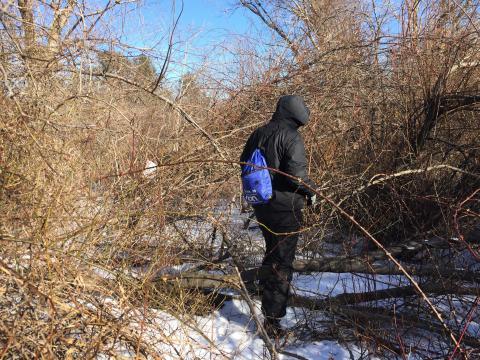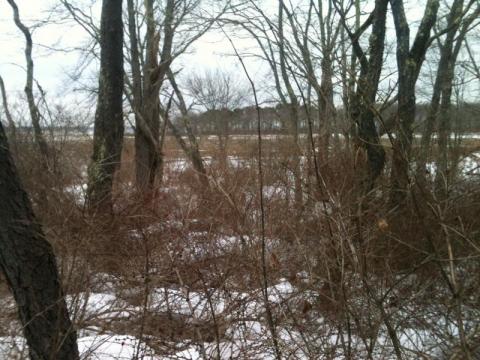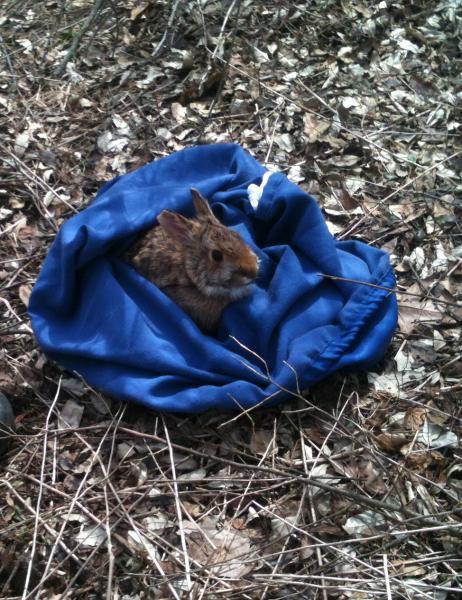
Melissa Bauer, a Ph.D. student studying New England Cottontails, and Sarah Towle, an undergraduate at UNH, make their way through multiflora rose thickets as they survey NEC habitat. Photo by Jenna O'del
“For the sake of science,” said Sarah Towle, a Wildlife and Conservation Biology major at the University of New Hampshire (UNH) as we forced our way through thickets early this year. We, along with fellow undergraduates in UNH’s College of Life Sciences and Agriculture, fought through bushes of thorns that were big and curved or that were like small needles. We dropped to our hands and knees to crawl on the snow. We twisted and turned, and yet still had thorns gouge our layers of pants.
We struggled through thorns because we were surveying for New England Cottontails (NEC), the native rabbit that is a conservation focus of researchers at UNH, NH Fish & Game Department, and UNH Cooperative Extension.
New England cottontails – not to be confused with the non-native eastern cottontail — are habitat specialists, preferring dense shrubland. They only live in that one type of habitat, and if that habitat isn’t there, neither are they. “Historically there was more shrubland habitat on the landscape,” Melissa Bauer, a Ph.D. student studying NEC with UNH professor Dr. Adrienne Kovach, said. Since the mid-20th century, shrubland habitat has declined along with regional land use changes.
As shrubland declined to the current patches scattered across the region, so too did NEC populations. NEC are frequent targets of predators, and they use the dense shrubland vegetation for protection. Which means if we want to conserve NEC, we have to manage, conserve, and create shrublands.
NEC are a focus of extensive regional conservation efforts, involving a diversity of groups ranging from organizations like NH Fish & Game, to institutions like UNH, to zoos, to the U.S. Fish and Wildlife Service, Bauer explained. UNH’s Cooperative Extension organizes many outreach events surrounding NEC conservation. These events encourage citizen scientists to help survey cottontail populations and habitat, along with educating them about NEC natural history, conservation, and wildlife research methods.

Shrubby habitat at a site inventoried for New England cottontail pellets. Photo by Melissa Bauer.
New England cottontails require a regional effort because they are an example of a species that relies on metapopulations. Normally, a species population refers to simply a group at a certain place during a certain time, as Kovach has described. A population may interact with others, but it tends to be separate from other populations, only breeding with individuals within its own population. With metapopulations, individuals of smaller populations move around and take up residence in other areas. These rabbits breed with others, sharing genes, or if there are no other New England cottontail present, they establish a new local population, which is known as colonization. This colonization is critical. Decades ago, if a “patch [of cottontails] went extinct because of a hard winter or high predation…it could get recolonized.” Bauer said. The recolonizing NEC then breed, and their descendants can in turn recolonize other patches and ensure future metapopulations.
But for this to happen, cottontails need to move through shrubland. “The landscape in between shrubland patches [used to be] more conducive to dispersal. They can’t really move through open fields or mature forests that well because they get predated really easily.” Bauer explained. “With the historical landscape there would be multiple patches of rabbit habitat…some were occupied, some weren’t, but there were enough… close together that rabbits could move between patches.” Bauer said. Now, because there is minimal habitat, local populations are practically isolated from others making them unable to recolonize shrubland patches if the population at one patch is eliminated. “It’s all about colonization.” Bauer summarized.
Colonization is a goal of captive breeding, another part of the NEC conservation effort, with zoos like Roger Williams Park Zoo in Rhode Island and the Queen Zoos in New York coordinating breeding programs. Captive-bred cottontails can be released into suitable shrubland to establish or augment existing populations and can then disperse to other patches to form metapopulations. When cottontails are released, their movements are tracked to see how many survive and where they go using either GPS and radio collars, or through another method: surveying their fecal pellets. Their poop.
As Sarah and I went through the thorns, we looked around for the small tan-colored pellets. When we saw them, we dropped our backpacks in the snow and put the pellets into a test tube, careful not to touch them. The pellets had NEC DNA we couldn’t contaminate. The DNA, with each individual having a unique DNA fingerprint (or in this case, poop-print), tells Bauer how many NEC are in an area. Pellet surveys are an alternative to live trapping, which would stress the easily-rattled NEC.
Another no-stress method of collecting data about cottontails is simply recording a rabbit sighting. UNH Cooperative Extension and NH Fish & Game run NH Rabbit Reports, a website where anyone can upload information about a rabbit sighting. The project is specifically interested in learning more about the distribution of eastern cottontail rabbits in order to understand their distribution in relation to New England cottontails.

New England cottontails are New Hampshire's only native rabbit and are a state-endangered species. Photo by Melissa Bauer.
If a pellet survey shows that multiple NEC are in an area, that area is likely comprised of “high quality dense shrublands.” Bauer said. This quality shrubland is not just important for NEC, though. NEC are considered indicator species - they indicate a certain quality of the environment in which they live. A variety of wildlife depend on shrubland for their entire lives, like indigo buntings and prairie warblers - both birds that have struggled just like the cottontail. Even wildlife that don’t constantly require shrubland, and only use it occasionally, need it. Bears, red foxes, and skunks eat the berries growing on shrubs, and snakes hunt in shrubland.
The efforts around New England cottontails are not just conserving New England’s native rabbit. They are also conserving all the other species that need shrubland, too. "For the sake of” many wildlife species, into the thorns we go.
You can help with NEC conservation, whether or not you want to go into the thorns: Visit nhrabbitreports.org to report sightings of rabbits, and check out naturegroupie.org to learn about volunteer opportunities that benefit wildlife and habitats. As Bauer said, NEC conservation is a regional effort. That means everyone—not just scientists.
By Jenna O'del
Taking Action for Wildlife Spring 2019 Newsletter
Jenna O’del is a junior in Wildlife and Conservation Biology at the University of New Hampshire, but is a proud Rhode Islander and competitive sailor and horse lover. She is a staff writer for UNH’s student newspaper, The New Hampshire, and has researched everything from plants, to burying beetles, to moose ticks. She intends to get her Ph.D. and become a research professor.


